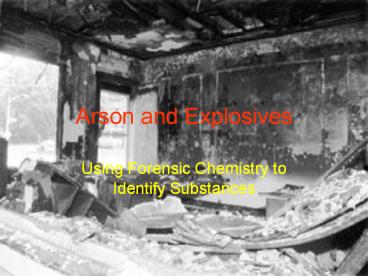Arson%20and%20Explosives - PowerPoint PPT Presentation
Title:
Arson%20and%20Explosives
Description:
Arson and Explosives Using Forensic Chemistry to Identify Substances Arson Incendiary Fires Accelerant something used to promote and spread a fire Solid ... – PowerPoint PPT presentation
Number of Views:215
Avg rating:3.0/5.0
Title: Arson%20and%20Explosives
1
Arson and Explosives
- Using Forensic Chemistry to Identify Substances
2
Arson Incendiary Fires
- Accelerant something used to promote and spread
a fire - Solid accelerants include paper, trash, highway
flares, black powder, paraffin and an oxidizer,
or sugar and chlorate. - Liquid accelerants include petroleum products,
alcohols, paint thinners, industrial solvents,
and ether. Either sloshed about or used in
firebomb (Molotov cocktail). - Gaseous accelerants include propane and natural
gas (disconnected gas line)
3
(No Transcript)
4
Incendiary Device
- Combine a means of ignition with a time delay.
- Candle is allowed to burn down to come into
contact with accelerant. - Fuses, flares, matches with lit cigarette,
chemical mixes, electronic devices.
5
Collection of Potential Evidence
- Use clean, vapor-tight containers.
- Screw-cap glass jars, metal cans, unused paint
cans with tight-fitting lids - Care must be taken to avoid loss of evidence due
to evaporation, and to avoid cross-contamination
of exhibits
6
Search for Evidence
- Some materials will survive the fire
- Start at point of origin (determined by arson
investigator) - Wires, batteries, bottles, wax, soap (used to
gel flammable liquid), ash residues, unburned
residual liquids
7
Testing Evidence
- Gas Chromatography
- Heat airtight container to drive volatile
residues from collected evidence - Remove vapor with syringe and inject into GC
- Unburned liquids can be removed from evidence by
steam distillation, vacuum distillation, solvent
extraction, solvent rinsing, or air flushing. - Compare resulting chromatogram with those of
known substances
8
Explosives
- 1920s - dynamite bombs used by political
anarchists aimed at rich and powerful, also used
by unions - 1930s the mob used stink bombs in theaters and
restaurants to persuade them to sell - November 1, 1955 midair explosion of United
Airlines flight 629 first bomb aimed at
general public
9
Bomb Investigations
- Investigation of flight 629 was very similar to
how such investigations are carried out today - Large grid was established (pieces were scattered
over a 5-mile radius) - Wreckage was pieced together, and it was
determined what type of bomb was used (from
residues) and where it exploded
10
Types of Explosives
- Low explosives cause relatively small damage
- Explode at a few thousand feet per second
- Emit low frequency sound (puff or boom)
- Examples are gasoline and gunpowder
- High explosives cause large damage
- 25,000 feet per second
- High-frequency blast
- Examples are dynamite and nitroglycerin
11
- Military Explosives TNT (trinitrotoluene), RDX,
PETN (Pentaerythritol Tetranitrate C5H8N4O12) - Commercial Explosives black powder, ANFO
(ammonium nitrate-fuel oil), dynamite,
nitrostarch - Improvised Explosives usually low explosives
(require confinement) homemade black powder,
fuel mixed with an oxidizer.
12
Crime Scene Searches
- Focus on blast seat
- Diligent search for remnants must be performed
- Explosive residues, metal fragments, fuse or
blasting cap, wire and/or insulation, electrical
tape, batteries, clocks or timers - FBI has extensive databases (batteries,
detonators, accessories, timers, radio-control
devices
13
Laboratory Tests
- Microscope locate unconsumed explosive
- Acetone is used to extract soluble explosives
from debris TLC or HPLC - Evidence is screened with an explosives
detector a special GC that identifies known
explosives.






























